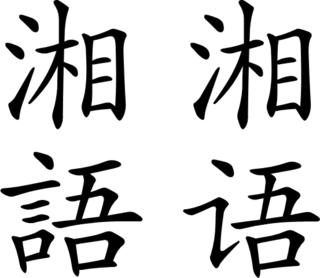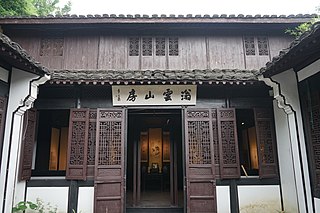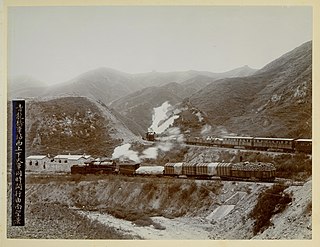Chinese classic texts or canonical texts refers to the Chinese texts which originated before the imperial unification by the Qin dynasty in 221 BC, particularly the "Four Books and Five Classics" of the Neo-Confucian tradition, themselves a customary abridgment of the "Thirteen Classics". All of these pre-Qin texts were written in classical Chinese. All three canons are collectively known as the classics.

China proper, Inner China or the Eighteen Provinces was a term used by Western writers on the Manchu Qing dynasty to express a distinction between the core and frontier regions of China. There is no fixed extent for China proper, as many administrative, cultural, and linguistic shifts have occurred in Chinese history. One definition refers to the original area of Chinese civilization, the Central Plain ; another to the "Eighteen Provinces" system of the Qing dynasty. There is no direct translation for "China proper" in the Chinese language due to differences in terminology used by the Qing to refer to the regions and the expression is controversial among scholars, particularly in China, due to national territorial claims.
The Manchu are an ethnic minority in China and the people from whom Manchuria derives its name. They are sometimes called "red-tasseled Manchus", a reference to the ornamentation on traditional Manchu hats. The Later Jin (1616–1636), and Qing dynasty (1636–1912) were established and ruled by Manchus, who are descended from the Jurchen people who earlier established the Jin dynasty (1115–1234) in China.
The Twenty-Four Histories, also known as the Orthodox Histories are the Chinese official historical books covering a period from 3000 BC to the Ming dynasty in the 17th century.

The Xinhai Revolution, also known as the Chinese Revolution or the Revolution of 1911, was a revolution that overthrew China's last imperial dynasty and established the Republic of China (ROC). The revolution was named Xinhai (Hsin-hai) because it occurred in 1911, the year of the Xinhai stem-branch in the sexagenary cycle of the Chinese calendar.

Liu Yizheng was a Chinese modern historian, calligrapher, librarian, cultural scholar, educator, and academic leader. He is known for his personal charisma, spirit and eruditeness. In modern Chinese academic field, it is said that the number of famous experts in various fields including in literature, history, geography, philosophy and even natural science he educated and enlighted was the most. Liu Yizheng and Wang Bohang were honorifically called Nanyong Double Pillars during early period of Republic of China.

Xiang or Hsiang, also known as Hunanese, is a group of linguistically similar and historically related varieties of Chinese, spoken mainly in Hunan province but also in northern Guangxi and parts of neighboring Guizhou and Hubei provinces. Scholars divided Xiang into five subgroups, Chang-Yi, Lou-Shao, Hengzhou, Chen-Xu and Yong-Quan. Among those, Lou-shao, also known as Old Xiang, still exhibits the three-way distinction of Middle Chinese obstruents, preserving the voiced stops, fricatives, and affricates. Xiang has also been heavily influenced by Mandarin, which adjoins three of the four sides of the Xiang speaking territory, and Gan in Jiangxi Province, from where a large population immigrated to Hunan during the Ming Dynasty.

Southwestern Mandarin, also known as Upper Yangtze Mandarin, is a primary branch of Mandarin Chinese spoken in much of central and southwestern China, including in Sichuan, Yunnan, Chongqing, Guizhou, most parts of Hubei, the northwestern part of Hunan, the northern part of Guangxi, and some southern parts of Shaanxi and Gansu. Some forms of Southwest Mandarin are not entirely mutually intelligible with Standard Chinese or other forms of Mandarin.

The queue or cue is a hairstyle worn by the Jurchen and Manchu people of Manchuria, and later required to be worn by male subjects of Qing dynasty China. Hair on top of the scalp is grown long and is often braided, while the front portion of the head is shaved. Some early modern military organizations have also used similar styles.

Suining County is under the administration of Xuzhou, Jiangsu province, China; it is the southernmost county-level division of Xuzhou and borders the prefecture-level cities of Suqian to the east and Suzhou of Anhui to the south and west.
The Historical Records of the Five Dynasties is a Chinese history book on the Five Dynasties period (907–960), written by the Song dynasty official Ouyang Xiu in private. It was drafted during Ouyang's exile from 1036 to 1039 but not published until 1073, a year after his death. An abridged English translation by Richard L. Davis was published in 2004.
The Draft History of Qing is a draft of the official history of the Qing dynasty compiled and written by a team of over 100 historians led by Zhao Erxun who were hired by the Beiyang government of the Republic of China. The draft was published in 1928, but the Chinese Civil War caused a lack of funding for the project and it was put to an end in 1930. Both of the current regimes claiming Greater China have attempted to complete it.
The History of Liao, or Liao Shi, is a Chinese historical book compiled officially by the Mongol Yuan dynasty (1271–1368), under the direction of the historian Toqto'a (Tuotuo), and finalized in 1344. Based on Khitan's primary sources and other previous official Chinese records, it exposes the Khitan people, Khitan's tribal life and traditions, and the Liao dynasty's official history.

Zhang Xuecheng was a Qing dynasty historian, writer and philosopher. His father and his grandfather had been government officials, but, although Zhang achieved the highest civil service examination degree in 1778, he never held high office. Zhang's ideas about the historical process were revolutionary in many ways and he became one of the most enlightened historical theorists of the Qing dynasty, but he spent much of his life in near poverty without the support of a patron and, in 1801, he died, poor and with few friends. It was not until the late 19th century that Chinese scholars began to accept the validity of Zhang's ideas.

Irgen Gioro is a Manchu clan and family name, which was officially categorized as a "notable clan", and member of the eight great houses of the Manchu nobility in Manchu Empire. Sibe and Nanai people also has Irgen Gioro as their family name.
The History of Song or Song Shi is one of the official Chinese historical works known as the Twenty-Four Histories of China that records the history of the Song dynasty (960–1279). It was commissioned in 1343 and compiled under the direction of First Minister Toqto'a and Prime Minister Alutu (阿鲁图/阿魯圖) during the Yuan dynasty (1279–1368) at the same time as the History of Liao and the History of Jin. Running to a total of 496 chapters, the History of Song includes biographies of the Song Emperors along with contemporary records and biographical sketches of Song dynasty politicians, soldiers and philosophers.

Dèng Guăngmíng was a Chinese historian who specialized in the 10th to 13th century Song, Jin and Liao dynasties.

The Historical Atlas of China is an 8-volume work published in Beijing between 1982 and 1988, edited by Tan Qixiang. It contains 304 maps and 70,000 placenames in total. The Concise Historical Atlas of China was published in 1991.
Zhou Zhenhe is a Chinese historical geographer and a distinguished senior professor at the Institute of Historical Geography of Fudan University in Shanghai. His main research interests are cultural and administrative geography and history of Sino-foreign cultural relations. He is the chief editor of the 13-volume General History of Chinese Administrative Divisions, published between 2007 and 2016.

The Beijing-Zhangjiakou Railway or Jingzhang Railway, also known as the Imperial Peking-Kalgan Railway, is China’s first railway that has been designed and built solely by Chinese, situated in the nation’s capital Beijing and Zhangjiakou City in Hebei Province. It was built in 1905–1909 under the proposal of Viceroy of Zhili Yuan Shikai (袁世凯) and Assistant Director-General of Railways Hu Yufen (胡燏棻), with Zhan Tianyou (詹天佑) or Jeme Tien Yow as engineer-in-chief. When building the railway, Zhan reduced the length of Badaling Tunnel by using a switchback—or “人”-shaped rail track called in China as the shape of it resembles the Chinese character “人” ; he also used vertical shafts to facilitate the excavation of the tunnel.















